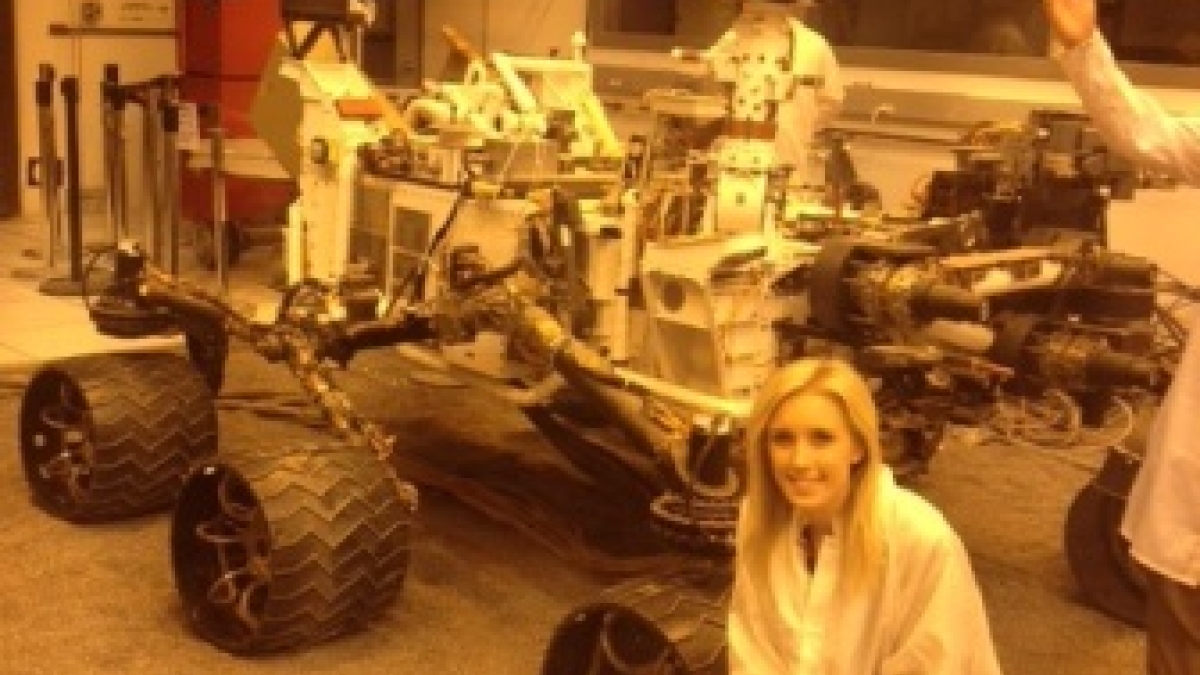ASU student spends summer interning at NASA

For 13 weeks over the summer, Arizona State University student Laura Fisher interned at NASA’s Jet Propulsion Laboratory (JPL) in Pasadena, Calif. It was an experience of a lifetime, one that allowed her to be part of a major milestone in space exploration: the landing of the Mars Curiosity rover.
Fisher, a senior majoring in business communications and minoring in astrophysics, learned about the internship by exploring the JPL website.
“After working for the Lunar Reconnaissance Orbiter Camera team for the last two and a half years, I’ve learned that the most important part of success is hands-on experience and networking. I’ve always dreamed about working for JPL one day and I knew that interning there would be my best shot at a job offer after graduation,” explains Fisher. “I didn’t expect for JPL to be offering a business internship being that they mainly seek out science or engineering majors but when I saw the business communications internship opening I was beyond thrilled.”
Fisher was originally hired by NASA’s Deep Space Network (DSN) as their business communication intern. The Deep Space program, which she describes as, “the backbone of NASA,” is an international network of three equidistant communication stations with large antennas that connects different exploratory missions, as well as observations of the solar system and universe.
During the internship, she focused on financial reports and analysis, as well as supporting the DSN’s educational and public outreach mission.
“I helped at JPL’s public viewing of the Venus transit, I worked the JPL Open House for the DSN, and I helped create an informational video for the Goldstone Apple Valley Radio Telescope (GAVRT) group, an educational program held at the school that is on the military base at Goldstone,” explains Fisher. “They are beta testing a new program that involves SETI (Search for Extraterrestrial Intelligence) and GAVRT by using the students to be able to look through all the data and static that they receive from the Goldstone Station’s antennas and look for a sign of extraterrestrial intelligence.”
Watch the video here: http://www.youtube.com/watch?v=2qJjBrVWFYI&feature=youtu.be.
Another public outreach task she took on was creating a video for the 35th anniversary of the launch of the spacecraft, Voyager. Her video showed the growing relationship between the DSN and Voyager over the last 35 years.
More aligned to her business communications degree, she also helped write estimate at completion reports for the DSN. These budget reports show the needed funding required to complete a project. This up-close view on creating, understanding, and analyzing budgets gave her great insight into the complexity of the financial aspects of NASA.
One of the highlights of the summer was being in such close proximity to the excitement surrounding Curiosity’s landing.
During the summer, Fisher had the privilege of seeing Curiosity’s engineering twin, a test rover used to simulate problems that might occur in actual day to day explorations (e.g., if the rover were to get stuck, researchers would simulate the terrain that it is stuck in and figure out which command works best to get it out.) The simulations are created in a warehouse called the In-Situ Instrument Lab (ISIL) which is designed to represent the Martian atmosphere. The floor is covered with cat litter to create a landscape that demonstrated how the rover would move on the ground as it explored the planet. Lights installed in the ceiling emit an orange haze that mock the sunlight that would be seen on Mars.
“I got to get up close and personal with the Curiosity twin because Professor Jim Bell was visiting JPL since he is a science team member for MSL’s Mastcam, MAHLI and MARDI cameras. He called me that day and asked if I wanted to check out the rover so [SESE alumna] Hallie Gengl and I rushed down to see it after he called us,” says Fisher.
All of the testing and waiting finally paid off as Fisher watched the video feed of Curiosity’s successful landing on Mars. She was invited to join in the excitement at JPL’s off site facility for Goldstone, located about 10 miles away from JPL, which served as JPL’s event overflow site.
For Fisher, being part of these projects during such an exciting time in space exploration is something she will never forget.
“I couldn’t think of a better way to spend my summer than the way that I did. Being able to walk into work at JPL everyday, seeing and meeting the masterminds behind all that is NASA from the scientists, engineers and business men and women was an awe-inspiring experience. I felt privileged to be in the same room with the people who made the MSL mission a success. It was such a monumental event that I’ll remember for the rest of my life,” she says.
This was the perfect opportunity for her to put to use what she had learned, not only as a business major, but also in astrophysics. She worked alongside those who are involved in the daily workings of a spacecraft that is exploring new worlds and helped others share that experience through her work with the public engagement team. She also witnessed the business side of exploration and the finer details that go into making these impressive projects feasible.
Written by Heath Harris
Media contact: